Hurricanes: Their Nature and Impacts on Society - Climate Science ...
Hurricanes: Their Nature and Impacts on Society - Climate Science ...
Hurricanes: Their Nature and Impacts on Society - Climate Science ...
You also want an ePaper? Increase the reach of your titles
YUMPU automatically turns print PDFs into web optimized ePapers that Google loves.
140 HURRICANES: THEIR NATURE AND IMPACT ON SOCIETY<br />
as an average, but it will also have a variance (i.e. spread around an average).<br />
Often, variability is just as or more important to decisi<strong>on</strong>-makers than the<br />
average (Katz <str<strong>on</strong>g>and</str<strong>on</strong>g> Brown 1992)!<br />
What, then, is a "normal" (i.e. typical) weather event? There are different<br />
ways to define normal weather. In some cases, "normal" is implicitly defined<br />
as the climate over a recent 30-year period, e.g. as has been d<strong>on</strong>e with respect<br />
to floods (FIFMTF 1992). Of course, it is possible to argue that <strong>on</strong> planet<br />
Earth all weather events are in some sense normal; however, such a definiti<strong>on</strong><br />
has little practical utility for decisi<strong>on</strong>-makers. One way to refine the c<strong>on</strong>cept is<br />
to define normal weather events as those events that occur within a certain<br />
range within a distributi<strong>on</strong>, such as, for instance, all events that fall within <strong>on</strong>e<br />
st<str<strong>on</strong>g>and</str<strong>on</strong>g>ard deviati<strong>on</strong> of the mean (Pielke <str<strong>on</strong>g>and</str<strong>on</strong>g> Waage 1987). In practice, historical<br />
records of various lengths <str<strong>on</strong>g>and</str<strong>on</strong>g> reliabilities have been kept around the<br />
world for temperature, precipitati<strong>on</strong>, storm events, etc. When data are available,<br />
such a statistical definiti<strong>on</strong> lends itself to equating normal weather with<br />
"expected" weather, where expectati<strong>on</strong>s are set according to the amount of<br />
the distributi<strong>on</strong> defined as "normal". For example, about 68% of all events<br />
fall within <strong>on</strong>e st<str<strong>on</strong>g>and</str<strong>on</strong>g>ard deviati<strong>on</strong> of the mean of a bell-shaped distributi<strong>on</strong>.<br />
A change in the statistical distributi<strong>on</strong> of a weather variable -such as that<br />
associated with a change in climate -is troubling because decisi<strong>on</strong>-makers<br />
may no l<strong>on</strong>ger expect that the future will resemble the past. For the insurance<br />
industry, as well as other decisi<strong>on</strong>-makers who rely <strong>on</strong> actuarial informati<strong>on</strong>,<br />
such a possibility of a changing climate is particularly troubling. A climate<br />
change is thus a variati<strong>on</strong> or change in the shape or locati<strong>on</strong> (e.g. mean) of a<br />
distributi<strong>on</strong> of discrete events (Katz 1993).<br />
"Extreme" weather events can simply be defined as those "not normal",<br />
depending <strong>on</strong> how normal is chosen to be defined. For instance, if normal<br />
weather events are those which occur within two st<str<strong>on</strong>g>and</str<strong>on</strong>g>ard deviati<strong>on</strong>s of the<br />
mean, then about 5% of all events will be classified as extreme. While it is<br />
possible to define hurricanes as "normal" <str<strong>on</strong>g>and</str<strong>on</strong>g> "extreme", the simple fact is<br />
that for most communities any l<str<strong>on</strong>g>and</str<strong>on</strong>g>falling hurricane would qualify as an<br />
extreme event, because of their rarity at particular locati<strong>on</strong>s al<strong>on</strong>g the coast.<br />
From the st<str<strong>on</strong>g>and</str<strong>on</strong>g>point of those human activities sensitive to atmospheric<br />
processes, it is often the case that decisi<strong>on</strong>s are made <str<strong>on</strong>g>and</str<strong>on</strong>g> decisi<strong>on</strong> processes<br />
established based <strong>on</strong> some set of expectati<strong>on</strong>s about what future weather or<br />
climate will be like. Building codes, l<str<strong>on</strong>g>and</str<strong>on</strong>g> use regulati<strong>on</strong>s, insurance rates,<br />
disaster c<strong>on</strong>tingency funds are each examples of decisi<strong>on</strong>s that are dependent<br />
up<strong>on</strong> an expectati<strong>on</strong> of the frequency <str<strong>on</strong>g>and</str<strong>on</strong>g> magnitude of future normal <str<strong>on</strong>g>and</str<strong>on</strong>g><br />
extreme events. Decisi<strong>on</strong>-making will take a different form in a situati<strong>on</strong><br />
where expectati<strong>on</strong>s are reliable <str<strong>on</strong>g>and</str<strong>on</strong>g> thought to be well understood than in a<br />
situati<strong>on</strong> of relative ignorance (Camerer <str<strong>on</strong>g>and</str<strong>on</strong>g> Kunreuther 1989).<br />
In short, many of society's decisi<strong>on</strong> processes are established based up<strong>on</strong> an<br />
expectati<strong>on</strong> of "normal" weather. Yet for most coastal communities "normal<br />
weather" has historically (or at least over the time of a human memory) meant














